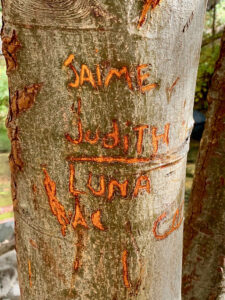A digital sign board greets visitors and residents traveling Highway 179 toward the Village of Oak Creek and Sedona, prominently stating: “YOUR PUBLIC LANDS, YOUR HERITAGE, RECREATE WITH RESPECT.” These words are embedded in the Leave No Trace philosophy we are encouraged to follow when we enjoy the many activities our public lands make possible. These words also form a mantra for the variety of local volunteer groups engaged in protecting or maintaining the heavily visited public lands surrounding us.
Some of the undesired impacts of recreation on our National Forests, such as trash and graffiti, can be mitigated with education, volunteer clean-up efforts, or even with law enforcement action. One particularly thoughtless act which cannot be repaired seems to be increasingly evident along the Oak Creek corridor and other local water recreation spots: carving on trees. The beautiful Arizona Sycamores of our riparian areas are often the targets of this type of vandalism.
 Carving on trees is not a new phenomenon. What is the harm? Friends of the Forest volunteer and horticulturalist Pauline Rosen said, “Trees don’t heal wounds. All they can do is compartmentalize damage by walling off an affected area. All of the water and nutrients that are transported throughout the tree move through its vascular system located just below the bark.”
Carving on trees is not a new phenomenon. What is the harm? Friends of the Forest volunteer and horticulturalist Pauline Rosen said, “Trees don’t heal wounds. All they can do is compartmentalize damage by walling off an affected area. All of the water and nutrients that are transported throughout the tree move through its vascular system located just below the bark.”
Depending on the depth of a cut, it may disrupt the inner bark which is essential living tissue. Cells called phloem carry nutrients, mainly sucrose, made during photosynthesis to all parts of the tree. Cells called xylem transport water and nutrients from the roots up to the rest of the tree.
In extreme cases, carving or other bark damage can cause a tree to starve to death due to disruption of this cellular system. Carving graffiti around the circumference of a tree trunk, called girdling, will likely kill the tree by starvation. “The Arizona Sycamore has only a thin layer of exfoliating bark which cannot mitigate damage like thicker bark trees may”, Rosen noted.
Trees can survive minor cuts by compartmentalizing and forming a callus over time. However, such injuries leave a tree vulnerable to disease, fungus and insects. Anthracnose is an insidious fungal disease which is already a considerable problem for Sycamores in our area. Prolonged drought, soil compaction, insects and even air pollution are further stressors for a damaged tree. Since some trees are linked together underground by root or fungal networks, pathogens can spread from one damaged tree to others.
Even if a tree heals, carvings are permanent marks. Unlike other forms of graffiti, they cannot be removed or cleaned, and will remain to potentially inspire copycat behavior by others. In times past, salves were applied to tree wounds to promote healing but have since been found to be ineffective, if not harmful. There is no treatment or mitigation for a graffiti damaged tree. Even the Friends of the Forest graffiti removal team, which spends hundreds of hours annually removing graffiti along trails and streams, cannot remediate this kind of damage.
Tree carvings leave a lasting impact on the landscape, affecting all who seek to enjoy our forests. And no, tree carvings do not move upward and disappear as a tree grows and matures. They remain at the same height as the day they were made. As we can see, scribbling initials in a tree on the side of a trail can have permanent effects for the tree and the ecosystem around it.
Cell phones, photographs and social media give us other ways to memorialize or share our experiences and let others know where we have been. By educating others and modeling respect for nature we can all protect our forests and Leave No Trace.
District Ranger for the Coconino National Forest Red Rock District, Amy Tinderholt, has this advice: “A romantic gesture could kill that beautiful tree. A photo with you and your sweetheart in front of that majestic tree is a better way to show your love for both your betrothed and that stunner that cleans the air, cools us with shade, provides habitat for wildlife and enriches the soil.”
Like the sign says: Our Public Lands, Our Heritage.
Learn more about volunteer opportunities supporting the Red Rock Ranger District of the Coconino National Forest at https://www.friendsoftheforestsedona.org